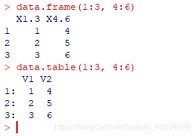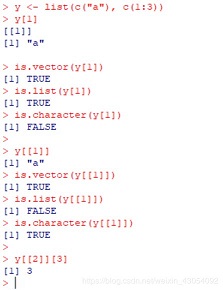新型冠状病毒让一个本来要提前去学校实习&写毕业论文的武汉大学生无限期地留守在家,实在受不了每天无所事事的自己了,还是学点什么充实一下生活,趁着情人节下定决心要开始好好学习男朋友不香吗 ,不管,今天就是一个执行学习计划的黄道吉日。
Why R?
其实很早之前,大概大一大二的时候,就上暑期课程学过一点R,但语言这种东西,不常使用就只能记个大概。从现在的形势来看,学好学精R,对我来说还是很有必要的。毕竟参加了学校的面试以后,面试官都有问我会不会R这样,所以还是重新开始系统地学习一下。
Why Advanced R?
之前的学习过程都是断断续续看《R语言实战》或者直接找别人的R语言学习笔记来完成需要R语言的作业的。上次看一篇博客说这本书还挺好的,刚好又是英文版,想着学R的过程中还能顺便学学英语,所以就这本咯~至于是不是比《R语言实战》更好,这里先不做评价噢,先看看我是不是能学完吧…
好了,话不多说,开始学习!
Introduction
Chapters 1-6: advanced programming techniques
Chapters 7-10: data management measures
Chapters 11-14: cloud computing with R (Amazon cloud)
Chapter 15: techniques in dynamic documents and reports
Chapter 1: Programming Basics
-Advanced R Software Choices
R and RStudio
Java
-Reproducing Results
install.pacackages("checkpoint")
library(checkpoint)
checkpoint("2020-02-14", R.version = "3.4.4")
library(data.table)
因为R的contributor有很多,为了后续保持版本相同这里使用checkpoint。但是我的R运行了老半天还报错,所以我没有用这个。
-Types of Objects
*Logical objects 布尔值
TRUE = 1
FALSE = 0
TRUE
FLASE
*intergers 整数
capital L suffix
42L
*double 双精度实数
1.5
*Complex numbers 复数
with i suffix
2+3i
*Nominal-level data 名义尺度数据
stored via the character alss and designated with quotation marks:
"a" ## character
*Missing values 缺省值
NA
NA_integer_
NA_real_
NA_character_
NA_complex_
*Factors 因子
A factor variable indicates that a variale should be treated discretely. Factors are stored as integers, with labels to indicate the original value.
factor(1:3)
factor(c("a", "b", "c"))
factor(letters[1:3])
*vector 向量
c(1,2,3)
*scalar 标量
c(1)
*matrix 矩阵
matrix(c(1:6), nrow=3, ncol=2)
*list 列表
A list is a vector of objects, in which each element of the list may be a different type.
list(
c("a"),
c(1, 2, 3),
matrix(c(1:6), nrow=3, ncol=2)
)
*data frame 数据框
Data frame is a particular type of list, in which each element of the list is identical in length.
data.frame(1:3, 4:6)
data.frame(1:3, letters[1:3])
*data table 数据表
Data tables are similar to data frames, but are designed to be more memory eficient and faster.
library(data.table)
data.table(1:3, 4:6)
这里data.frame和data.table的结果是不同的:

-Base Operators and Functions
*assignment 赋值
= and <- are both assignment operators, but for clarity’s sake, <- is recommended for general assignment.
x <- 5
y = 3
使用函数check一下:

从这里可以看到,使用<-赋值得到的是向量,而=赋值得到的是实数。
*index 索引
R starts indexing at 1.
x <- c("a", "b", "c")
x[1]
*subsetting 取子集
x2 <- matrix(c(1:6), nrow=3, ncol = 2)
x2[1, 2] ## row 1, column 2
x2[1, ] ## all row 1
x2[, 1] ## all column 1
x2[c(1,2), ] ## all rows 1 and 2
x[-2] ## drop element two
x2[, -2] ## drop column two
x2[-1, ] ## drop row 1
*accessing 取值
A single index in a single bracket returns the entire element at that spot. Using double brackets returns the object within that element of the list.

Named data frames and lists can use the $ operator to access components.
x3 <- data.frame(A = 1:3, B = 4:6)
y2 <- list(C = c("a"), D = c(1, 2, 3))
x3$A
y2$C
x3[["A"]]
y2[["C"]]
x3[1, "A"]
x3[, "A"]
每行和每列也可以有单独的命名,后续可以用这个命名来取值:
rownames(x3) <- c("first", "second", "third")
x3["second", "B"]
在data tables中,取行值与上述一样,但是取列值的时候可以不需要引号:
x4 <- data.table(A = 1:3, B = 4:6)
x4[1, ]
x4[, A]
需要用多个命名取值的时候可以用 .()操作符:
x4[1:2, .(A, B)]
如果要使用引号取值时,要加上option:with = FALSE:
x4[1, "A", with = FALSE]
当然,我试了一下不加这个option,并没有报错。而且用is.matrix(), is.vector()以及is.charactor()检验了一下,结果全都是FALSE。
这一段后面还讲了 “[” “]” 其实也是函数,只不过没有名字而已bracket好惨,不配拥有姓名
还介绍了一些其他的取值方式,真是令人大开眼界
'['(x, 1)
'['(x3, "second", "A")
但我感觉取值这样,还是按照自己的习惯就好了,搞太多花式取值也难为别人…
*inherits()
这个函数就是为了补充is.class()函数的:
inherits(x3, "data.frame")
inherits(x2, "matrix")
结果就是布尔值,TRUE或者FALSE。
*coercion 强制转换
强制转换有风险,使用需谨慎。
as.integer(3.8)
as.integer(3.2)
输出结果一样,都是3,实数强制转换为整数时只取整数部分。
as.character(3)
as.numeric(3)
as.complex(3)
as.factor(3)
as.matrix(3)
as.data.frame(3)
as.list(3)
as.logical("a")
输出结果为“NA”
as.logical(3)
输出结果为TRUE,除0外所有实数,输出结果均为TRUE
as.logical(0)
输出结果为FALSE
as.numeric("a")
输出结果为“NA”,并且含有warning,警告因为强制转换出现缺省值
-Mathematical Operators and Functions
*comparison 比大小
4 > 4
4 >= 4
4 < 4
4 == 4
4 != 4
这里注意 “=” 是赋值, “==”是比较是否相等。
由于不同编程环境的浮动小数显示不同,所以我们可以限定精度(tolerance):
all.equal(1.0002, tolerance = .01)
*logic operators 逻辑运算符
& for AND
| for OR
TRUE | FALSE
TRUE & FALSE
c(TRUE, TRUE) | c(TRUE, FALSE)
c(TRUE, TRUE) & c(TRUE, FALSE)
如果只想要一个输出结果,可以用 “&&” “||”:

any(c(TRUE, TRUE, FALSE))
all(c(TRUE, FALSE, TRUE))
*mathematical operators 数学运算符
| 运算符 | 含义 |
|---|---|
| + | 加 |
| - | 减 |
| * | 乘 |
| / | 除 |
| ^ | 乘方 |
| %/% | 取商 |
| %% | 取余数 |
| %*% | 矩阵相乘 |
还有一些函数:
sqrt(3)
abs(-3)
exp(1)
log(2.71)
可以用 ?Arithmetic 来查询一些数学运算符。
三角函数:
cos(3.1415)
sin(3.1415)
可以用 ?Trig 来查询三角函数。
矩阵运算:
t(x2) ##将x2转置
crossprod(x2) ##内积
tcrossprod(x2) ##外积
Chapter 1愉快地结束啦~~
